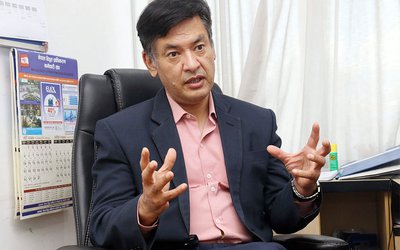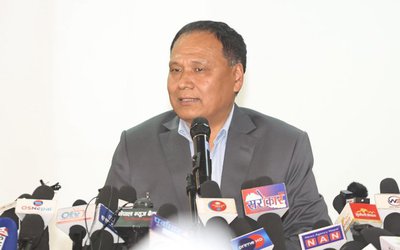

At a time when various Transmission Lines Projects across the country are experiencing delays due to disruptions and non-cooperation, the timely completion of construction is being hindered. This has led to increased total costs and a slowdown in progress.
During the inauguration of the Masryangdi-Kathmandu Transmission Line and Matatirtha Substation, Kul Man Ghising, the Managing Director of Nepal Electricity Authority, likened completing a transmission project to winning a major battle.
He emphasized the importance of meeting government and public expectations for rapid development, highlighting the need for legislative changes and a conducive environment.
Ghising stressed that addressing challenges related to land acquisition and tree cutting is crucial for completing development projects within set timelines and budgets.
During the inaugural event attended by Prime Minister Pushpa Kamal Dahal Prachanda, the Minister of Energy, Water Resources and Irrigation, and other high-ranking officials, Ghising emphasized the importance of timely completion of transmission lines.

MD Ghising has been dedicating a significant amount of time to inspecting the transmission line projects in order to resolve any obstacles hindering their completion. By holding discussions with officials from the Ministry of Forest, local leaders, and individuals causing obstructions, MD Ghising has been fostering a favorable environment for the projects.
The efforts of MD Ghising are yielding positive results. The long-delayed 400 kV Hetauda-Itahari Transmission line has made substantial progress in recent years due to the removal of obstacles. Similarly, the 220 kV Bardaghat-New Butwal Transmission line project is nearing completion.
After facing delays for an extended period, the 220 kV Chilime-Trishuli 3 B Hub Transmission line project is on the verge of being energized. Additionally, the 400 kV Barabishe-Lapsifedi Transmission line project is also progressing forward.
PM Backed MD Ghising
Prime Minister Prachanda expressed his support for MD Ghising and encouraged all relevant agencies to collaborate in order to expedite the country's development.
Stressing the importance of continuing developmental projects without interruption, he emphasized the need for key decisions to enhance programs while maintaining a balance between development and environmental concerns.
Prachanda urged all stakeholders to prioritize practicality over hindrances in the development process. Furthermore, he underscored the significance of a significant advancement in hydropower development and encouraged the nation to seize the opportunities for progress. The Prime Minister also highlighted Nepal's potential for hydropower investment and commended the government's policies for attracting both local and foreign investors.
He announced the imminent finalization of a tripartite agreement between Nepal, India, and Bangladesh for the export of 40 megawatts of electricity to Bangladesh, commencing in the upcoming fiscal year.
Prime Minister Prachanda emphasized the need for related agencies to adopt a practical approach rather than being anti-developmental in order to address the issues surrounding forest area land use and tree cutting in development projects, particularly transmission lines.
He highlighted the escalating costs and delays associated with these projects, which hinder both progress and the aspirations of the people for development. Despite these challenges, he underscored the importance of not halting development projects, but rather making crucial decisions to ensure a harmonious balance between development and environmental conservation.
Additionally, he mentioned the government's efforts to address the seasonal imbalance in the electricity system through the advancement of key hydropower projects such as the Budhigandaki Reservoir Hydropower Project, Upper Arun Half Reservoir Hydropower Project, and Dudhkoshi Reservoir Hydropower Project.
PM Prachanda inaugurated the transmission line and substation at the substation complex in Chandragiri municipality-8 of Kathmandu. The Matatirtha substation, with a capacity of 220÷132 KV and 320 MVA, is the largest substation hub for power supply in the Kathmandu Valley.
The construction of the Masryangdi-Kathmandu 220kV double circuit transmission line and the 220kV Matatirtha substation was aimed at bringing electricity from the Masryangdi river watershed area to the Kathmandu Valley. These projects have now been officially inaugurated
Minister of Energy, Water Resources, and Irrigation Shakti Bahadur Basnet emphasized the progress being made in hydropower projects under the People's Hydropower Program. He highlighted the investments made by the federal, state, and local governments, as well as Nepal as a whole. Furthermore, he mentioned the successful organization of the power generation, transmission, and distribution sector.
The Norwegian Ambassador to Nepal, Torun Dramdal, commended Nepal's significant achievements in the construction of electricity transmission and distribution lines. She emphasized that such infrastructure development would reduce the reliance on imported cooking gas and encourage the consumption of affordable electricity.
Yingming Yang, the Vice President of the Asian Development Bank (ADB), acknowledged the construction of transmission lines and substations as a crucial milestone in Nepal's energy sector development. He assured continuous support from the ADB in advancing the energy sector.
The Masryangdi-Kathmandu 220 KV double circuit transmission line has been successfully constructed, connecting the Markichoke substation at Ambukhairni in Tanahun to Kathmandu. This transmission line enables the transportation of power from the Masryangdi river watershed area to the Kathmandu valley. Spanning a length of 82 km, the transmission line passes through Tanahun, Gorkha, Chitwan, Dhading, and Kathmandu, with a total of 233 towers. Currently operational at 132 KV, the transmission line is effectively delivering electricity.
The transmission line connecting Masryangdi-Kathmandu and Trishuli-Kathmandu has been successfully interconnected at Badbhanjang, in Chandragiri municipality. This integration has been achieved by linking the Markichoke to Badbhanjyang section of the Masryangdi-Kathmandu transmission line and the Trishuli-Kathmandu 220 kV transmission line. These two transmission lines, along with their four circuits, have been seamlessly integrated into the Matatirtha substation.
This integration will enable the transmission of approximately 1-1000 megawatts of electricity from the Masryangdi-Kathmandu and Trishuli-Kathmandu transmission lines to Badbhanjyang. From there, around 2000 megawatts of electricity will be further transmitted and integrated into the Matatirtha substation through the multi-circuit transmission line.
The significance of this interconnected transmission line and substation cannot be overstated. As the electricity generated in the Masryangdi and Trishuli river basins flows, this infrastructure will serve as the backbone to meet the future electricity demand of Kathmandu Valley and enhance the overall electricity system of the country.
The construction of the Masryangdi-Kathmandu transmission line commenced in August 2073, following a contract signed with the Indian company Tata Project Ltd. on 16 June 2073 at 9:00 PM. The project faced some delays due to local obstructions and the impact of the Covid-19 pandemic. Particularly, the obstruction caused by the locals in Siddlake Rural Municipality-7 of Dhading resulted in a delay of nearly two years.
Following the unsatisfactory performance of the company initially contracted for the construction of Matatirtha and Markichoke substations, the contract was terminated. Subsequently, a new contract was established with China Masonry Engineering Corporation in 2077, and the remaining construction work was progressed accordingly.
As of now, the construction of Matatirtha substation has been successfully completed, while the construction of Markichoke substation is currently in its final stage.
Moreover, the Masryangdi-Kathmandu transmission line project has commenced with investments from the Nepal government and the authority, along with subsidies from the Norwegian government and a concessional loan from the Asian Development Bank. The estimated cost of this project amounts to approximately 8 billion rupees.
Upon the project's conclusion, Kathmandu Valley, serving as the primary load center, will possess sufficient electricity to cater to the escalating demand and facilitate the transmission of electricity beyond the valley. Consequently, this project holds immense strategic significance in ensuring a consistent power supply in Kathmandu.
- Nepal’s Snow Leopard Population Reached 397
- Apr 22, 2025
- Education Minister Bhattarai resigns from post
- Apr 22, 2025
- Foreign Minister Dr. Deuba Chaired Asia-Pacific region confronting
- Apr 21, 2025
- Nepal Electricity Authority cancels contract worth over Rs 1 billion, now electricity wires going to customers' homes are bare
- Apr 21, 2025
- Four people died in Taplejung after their vehicle caught fire after getting entangled in a live wire
- Apr 21, 2025















